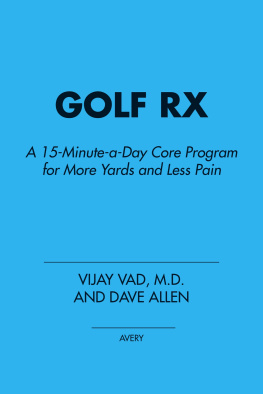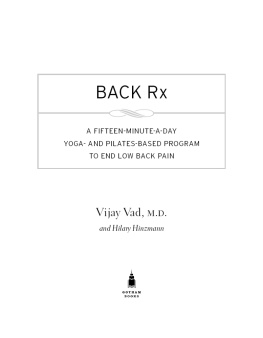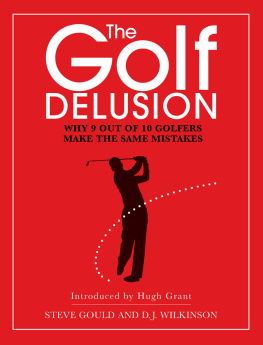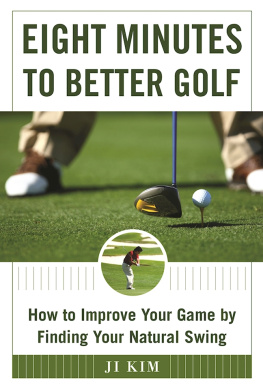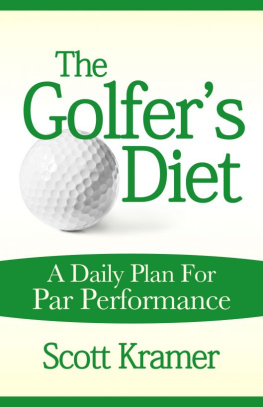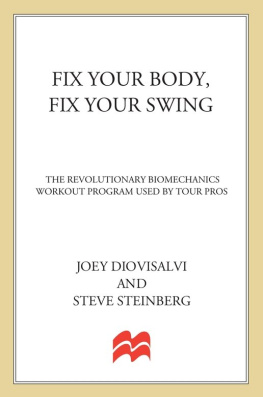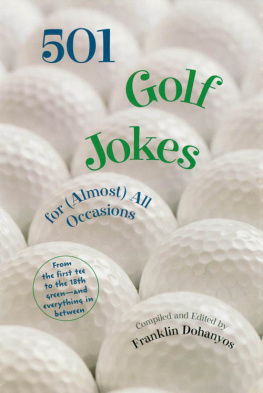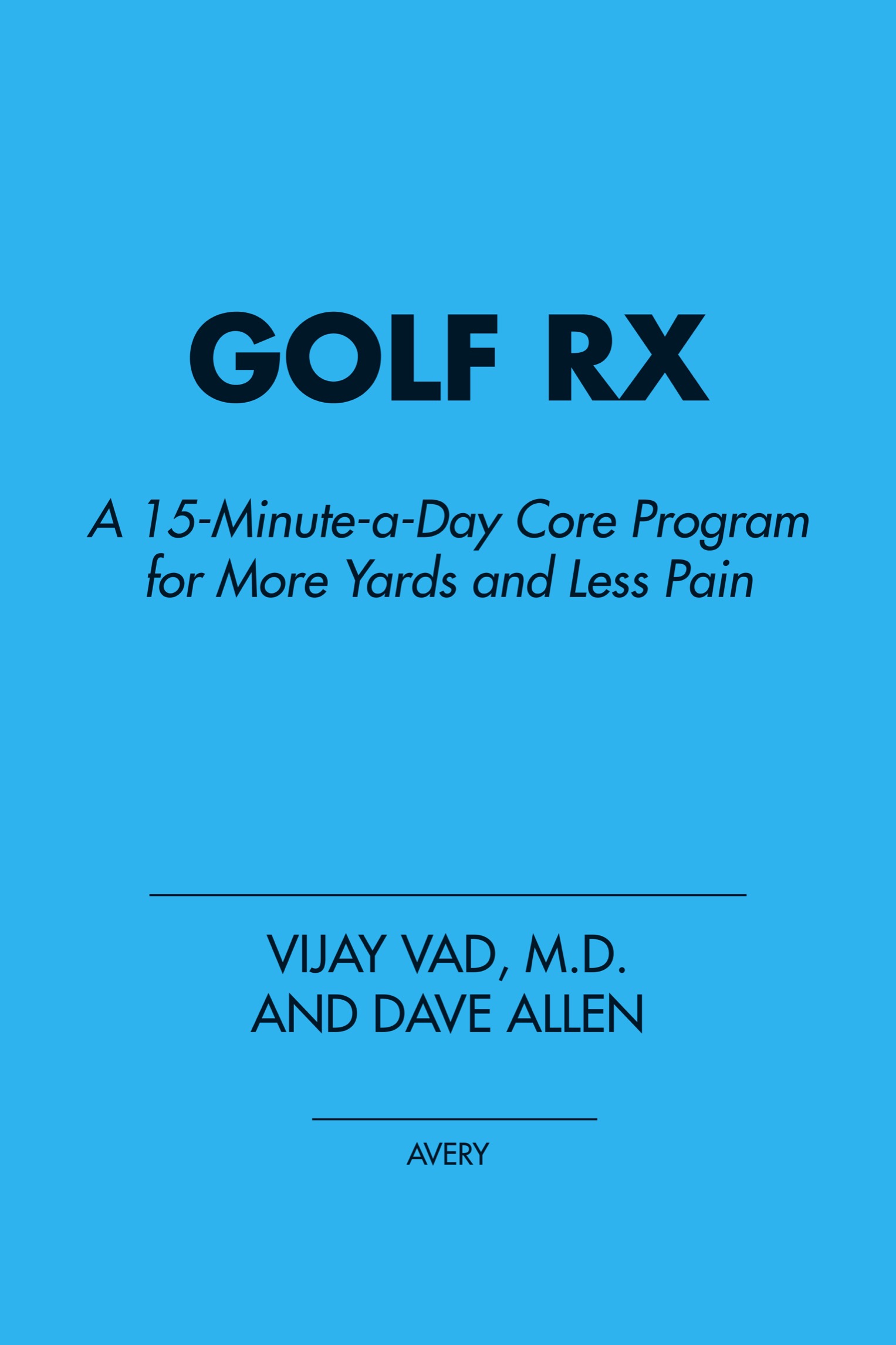Also by Vijay Vad, M.D.
GOLF Rx
A FIFTEEN-MINUTE-A-DAY CORE PROGRAM
FOR MORE YARDS AND LESS PAIN
Vijay Vad, M.D., with DAVE ALLEN

Every effort has been made to ensure that the information contained in this book is complete and accurate. However, neither the author nor the publisher is engaged in rendering professional advice or services to the individual reader. The ideas, procedures, and suggestions contained in this book are not intended as a substitute for consulting with your physician. All matters regarding your health require medical supervision. Neither the author nor the publisher shall be liable or responsible for any loss, injury, or damage allegedly arising from any information or suggestions in this book.
GOTHAM BOOKS
Published by Gotham Books, a member of Penguin Group (USA) Inc.
penguinrandomhouse.com
Copyright 2007 by Vijay Vad, M.D.
Exercise photos by William Cahill and Kelly Kline
Photos Nucleus Medical Art/Phototake
Vijay Singh photos by Fred Vuich/ GOLF Magazine
All rights reserved
Gotham Books and the skyscraper logo are trademarks of Penguin Group (USA) Inc.
LIBRARY OF CONGRESS CATALOGING-IN-PUBLICATION DATA
Vad, Vijay.
Golf Rx: a 15-minute-a-day core program for more yards and less pain /
Vijay Vad, with Dave Allen.
p. cm.
ISBN: 978-1-1012-1685-9
1. GolfersHealth and hygiene.
2. Golf injuriesPrevention. 3. GolfPhysiological aspects.
I. Allen, Dave, 1968II. Title.
RC1220.G64V33 2007
617.1'027dc22 2006027207
Without limiting the rights under copyright reserved above, no part of this publication may be reproduced, stored in or introduced into a retrieval system, or transmitted, in any form, or by any means (electronic, mechanical, photocopying, recording, or otherwise), without the prior written permission of both the copyright owner and the above publisher of this book.
The scanning, uploading, and distribution of this book via the Internet or via any other means without the permission of the publisher is illegal and punishable by law. Please purchase only authorized electronic editions, and do not participate in or encourage electronic piracy of copyrighted materials. Your support of the authors rights is appreciated.
While the author has made every effort to provide accurate telephone numbers and Internet addresses at the time of publication, neither the publisher nor the author assumes any responsibility for errors, or for changes that occur after publication. Further, the publisher does not have any control over and does not assume any responsibility for author or third-party Web sites or their content.
Version_2
To my beautiful daughter Amoli.
May she appreciate good sportsmanship
and strive to leave the world a better place
than how she found it.
INTRODUCTION
THE GOLF Rx WAY TO A BETTER SWING
A few summers ago, I received an emergency phone call from a fifty-two-year-old patient of mine who had collapsed on the 17th green at Shinnecock Hills Golf Club (site of the 2004 U.S. Open) on Long Island. He was about to putt for a birdie when he reached down to pick up his marker and suddenly crumpled to the ground in a heap, pain radiating through his buttocks and down his right leg.
After being taken by ambulance to the local emergency room, he was transported back to the Hospital for Special Surgery in New York, where I treated him for a bulging disk in his lower back. The disk was pressing up against his sciatic nerve, causing tremendous pain and immobility. After giving him an epidural injection at the spot where the nerve and protruding disk met, he was standing again. That was the good news. The bad news: It would be about two months before hed be attempting another birdie putt.
In this particular instance, it was early in the season, the golfer had only a round or two under his belt, and his body was in no condition to handle the rigors associated with playing eighteen holes of golf. He had been golf deconditioned after several months away from the game, and he was hurrying back too soon without getting his body in golf shape.
Ive seen this type of injury countless times in my ten years as a physician at the Hospital for Special Surgery, a world-renowned sports medicine institution that provides services for the ATP mens professional tennis circuit, the U.S. swimming and rowing teams, the New York Mets baseball team, the New York Knicks basketball team, and the New York Giants football team, among others. During that time, Ive treated more than 3,000 golfers, half of them with back-related injuries. It is the most common sports injury I see among fifty-and sixty-year-old men. In fact, it is estimated that half of all recreational golfers and one-third of all professional golfers suffer from some form of lower-back pain.
In my role as a consulting physician for the PGA Tour, the tour asked me in 2001 to conduct a study on the causes of lower-back pain in professional golfers. It was a parallel study to the one I conducted on the ATP tennis tour in 19992000. Up until this time, it was widely believed that the violent, twisting nature of the golf swing and the tremendous forces imparted on the spine were the cause of lower-back problems. But our research showed that the back was only partially to blame.
We tested forty-two PGA Tour professionals at the 2001 Buick Classic (now referred to as the Barclays Classic, for which I serve as the medical director) in Westchester County, New York, and found that those who suffered from lower-back pain had substantially less flexibility in their lead hipthe left hip for right-handed golfersversus their trailing hip. In those players who didnt suffer from lower-back pain, the lead-hip discrepancy wasnt as significant.
This made a whole lot of sense because in the golf swing, rapid deceleration takes place the moment you contact the ball. In less than a second, your swing goes from eighty-to ninety-plus miles per hour to a complete stop. Just try asking your car to do that without burning the rubber on your tires down to the pavement! If theres little range of motion in your lead hip, your body is not going to be able to withstand these deceleration forces very well, and your back will become the primary shock absorber. These deceleration forces have to be absorbed by your whole body, and if one part of that system (your hips) is not doing its job, its going to move on to the next part of the system, which is your lower back, and so on. The key is that you dont want so many forces getting to your back so soon; you want them to dissipate before they get there.
It was from this research published in the prestigious American Journal of Sports Medicine that Golf Rx was born, which makes it the first golf-fitness book on the market today based on a clinical study of PGA Tour professionals. Golf Rx contains three step-by-step exercise series and more than eighty core-specific exercises designed to increase the range of motion in your lead hip, as well as improve your overall flexibility, strength, and endurance so that you can enjoy the game pain-free for the duration of the seasonand longer.
However, Golf Rx is more than a book about injury prevention; it seeks to improve your performance on the course as well. By progressing through the golf-specific exercise programs, you will hit the ball farther and straighter than ever before. Your swing mechanics will improve, and so will your consistency of play and your ball-striking. In this aspect, Golf Rx is different from my first two books, Back Rx and Arthritis Rx . It is not only a book about treating pain and preventing future injuries, its about improving your level of play so you can break 90 or 80 for the first time in your life, regardless of your age.

